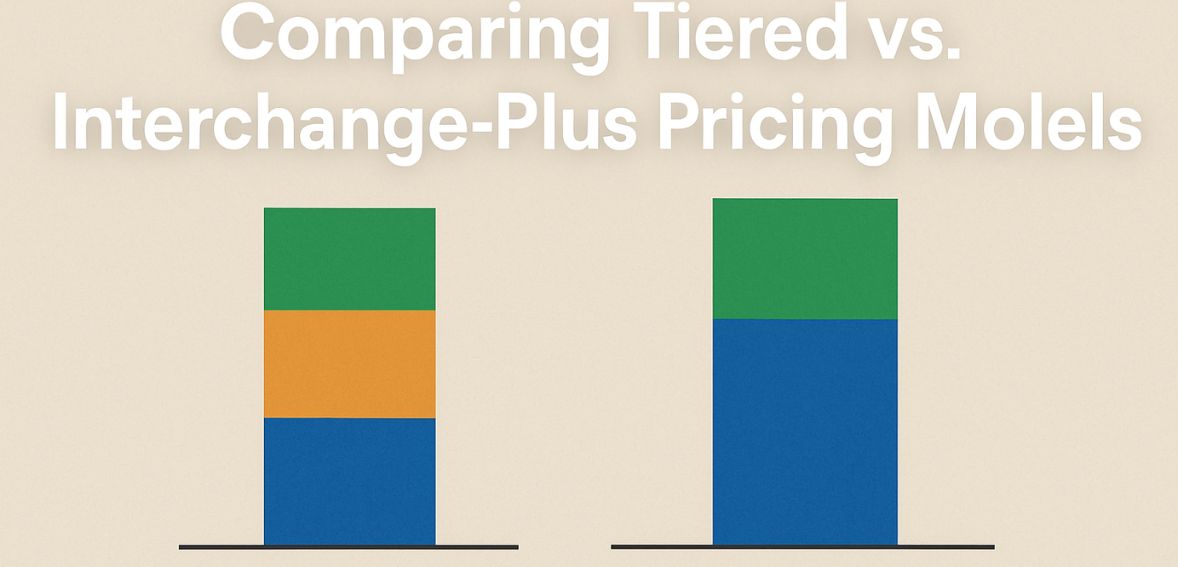
By Tilly Talbot August 10, 2025
Choosing the right pricing model for credit card processing isn’t just a back-office decision—it directly affects your bottom line and your relationship with every client you serve. Between tiered pricing and interchange-plus models, the differences go far beyond just numbers on a statement.
Each model shapes how fees are structured, how transparent your costs are, and how much control you truly have. In this article, we’ll take a closer look at what sets these models apart, how they impact businesses in real-world scenarios, and why making the right choice now could mean saving thousands down the road.
Understanding the Foundations: What Are These Pricing Models

The interchange fee, which is a fixed cost set by card networks such as Visa and Mastercard and usually ranges from 1.5% to 2%, is at the center of every credit-card transaction. That interchange fee serves as the non-negotiable base that banks receive in both models.
Behind-the-scenes costs are streamlined through tiered pricing, which divides them into categories such as “qualified,” “mid-qualified,” and “non-qualified,” each with a different markup rate. These classifications hide the precise cost of every transaction and allow processors to move transactions to higher tiers, which frequently results in a subtle increase in your expenses.
On the other hand, Interchange-Plus pricing—also referred to as cost-plus or passthrough pricing—is more open. A fixed processor markup (for example, +0.3% + $0.10) is added to the precise interchange fee for each transaction. There is no misunderstanding or surprise thanks to this structure, which makes it obvious what the card network charges and what goes to your processor.
Why Interchange-Plus Often Outperforms Tiered Pricing
For many business owners, transparency is essential. While Tiered hides all of its logic behind category labels, Interchange-Plus pricing makes clear what you’re paying to your processor and card networks. Even worse, unless your volume is uniform and your clientele only uses “qualified” cards, the tiered structure enables processors to push transactions into higher-margin tiers, which frequently results in higher costs.
Conversely, Interchange-Plus matches your fees to real expenses. Your savings will increase as you process more and bargain for better markups. That difference can grow significantly over time.
When Tiered Pricing Makes Sense

There are benefits to simplicity, so tiered pricing isn’t always a bad thing. In many cases, flat‑rate credit card processing offers that same one‑rate‑fits‑all clarity—making setup, budgeting, and onboarding easier for small merchants. But, as your payment volume grows, that simplicity might cost you in the long run.
It is frequently combined with sign-up bonuses or fixed monthly fees that are attractive in situations where cost analysis seems excessive, given your workload. Tiered is a short-term convenience rather than a long-term strategy, though, as this simplicity is frequently bought at the expense of efficiency.
When Interchange-Plus Is the Smarter Choice
Interchange‑Plus is probably a better option if your company is growing, processing a variety of card types, or handling a high volume of transactions. This structure supports interchange optimization—letting you lower your costs through smarter routing, card-type preferences, and data-level strategies as your scale increases.
However, keep in mind that not every Interchange-Plus offer is created equal. Some providers add extra charges, such as a false “foreign handling” quote, to make your statement seem transparent while concealing actual expenses. Significant savings can be obtained by requesting a thorough breakdown, reviewing financial records, and negotiating on the basis of actual volume.
What Real Merchants Are Saying
A seasoned voice in the retail trenches puts it simply: “Interchange-Plus is clear, with fees aligned to what I use. But if you don’t pay attention, you can still overpay. Watch the markup.” Another merchant warns: “Some reps promise sweeping savings with flat-rate models. It’s rarely as lucrative as it seems.”
Their takeaway? Education is power. Pricing models may have standards, but how processors implement them varies—learn the lingo and follow the numbers.
Deep Benefits of Interchange-Plus
There are other benefits besides transparency. You can adjust strategies like directing customers toward less expensive card types or streamlining checkout procedures when your processor distinguishes between interchange and markup. Your statement transforms from a bill into a performance metric.
Additionally, Interchange-Plus scales. Reduce markups as your company expands. Examine and understand the effects of new transaction types, such as international cards and e-commerce. Tiered pricing, on the other hand, may force you to pay ambiguous fees that increase erratically as complexity increases.
How Transparency Shapes Trust and Retention

Although pricing mechanisms are important, long-term partnerships between companies and their payment processors are frequently shaped by the model’s transparency. Merchants are much less likely to feel taken advantage of or overcharged if they know what they’re being charged and why.
By design, Interchange-plus provides a more transparent breakdown of the allocation of every cent. It can be empowering to have that clarity. It is simpler for a merchant to defend that expense when they can see that the fee is directly related to the amount that Visa or MasterCard charges. It feels less like price gouging and more like passing through.
That trail, however, is often obscured by tiered pricing, particularly when rates change without explicit documentation. Trust is frequently more about how well you know the structure behind it than it is about the absolute rate.
Many entrepreneurs are prepared to pay a little bit more for predictability, but not for simplicity disguised as unpredictability. Transparency then turns into a benefit for the company. Unambiguous pricing boosts trust, reduces attrition, and fosters a closer bond with the payment partner.
What Tiered Pricing Gets Right
Even though tiered pricing is frequently criticized, it’s critical to recognize that the goal of this model was simplicity rather than deception. One consistent rate can be a relief, particularly for small business owners who are managing dozens of duties. The cost is clearly understood, you swipe, and you get paid.
Salespeople can also explain it with ease. Merchants don’t need to be informed about risk categories, card brands, or interchange rates. Rather, a straightforward “qualified, mid-qualified, and non-qualified” model is presented. Until the company expands, this simplicity may seem alluring.
This is where it fails, though, because the lack of transparency becomes more noticeable as the volume and diversity of transactions rise. Without providing a clear explanation, business owners may observe that an increasing percentage of their transactions are in the more expensive “non-qualified” tier. What began as convenience eventually starts to resemble manipulation.
Additionally, merchants are frequently left wondering if the rate they are paying is reasonable or exaggerated in the absence of itemized reporting or a clear picture of actual interchange fees. A subset of businesses may find success with tiered pricing, but it requires caution, particularly if growth is a goal.
Interchange-Plus for Niche Industries: A Strategic Advantage

When it comes to processing payments, some industries—such as expensive retail, healthcare facilities, or business-to-business services—face particular difficulties. They rarely benefit from tiered pricing’s one-size-fits-all design. Conversely, interchange-plus enables far more detailed customization and analysis, which can be crucial for these specialized markets.
Consider a chiropractic office. Despite handling fewer transactions, their average amounts are higher. The business owner can make data-driven decisions about scheduling, equipment, and card policy by reviewing interchange charges by card type, issuer, and method of entry.
In a similar vein, B2B companies frequently use Level 2 and Level 3 data, which unlock much lower interchange rates—rates that, in a tiered system, would never reach them. Businesses can transparently qualify for these reduced costs through interchange-plus pricing. This eventually adds up to strategic planning as well as cost savings.
You are no longer restricted to a strict model or working in the dark. You can adapt to new card types, create loyalty programs, and change with the times while still having complete control over how your company is being charged. For companies with complicated or changing needs, that flexibility is priceless.
Choosing a Partner, Not Just a Plan
In the end, the pricing model is important, but so is the processor you decide to use. In the hands of a dishonest partner, a fair interchange-plus rate can become as problematic as tiered pricing with unstated fees. The way your provider interacts, adjusts, and fosters your development is what matters most.
Seek out processors who are more than just numbers. Do they provide monthly reports that aid in trend analysis? Will they respond to inquiries, clarify your claims, and review your pricing plan as your company develops? Pricing is a matter of values, not just math. Are you collaborating with someone who views your success as their own, or are they merely using it as a source of income?
Pricing is a matter of values, not just math. Are you collaborating with someone who views your success as their own, or are they merely using it as a source of income? When paired with the appropriate partner, the right pricing model becomes a tool for empowerment rather than frustration.
Take the time to learn about the inner workings of your business, whether you’re just getting started or you’re reviewing your setup after years of operation. Pose challenging queries. Anticipate truthful responses. Because, like most things, what is hidden in payments frequently ends up costing the most in the long run.
Advice for Deciding
Here’s how to go about making this choice:
- Assess your transaction profile: Average ticket size, card types, share of e-commerce vs in-person.
- Request sample merchant statements: Compare what your Tiered provider charges vs a quote on Interchange‑Plus. Ask to see “Interchange + markup” specifics.
- Understand provider terms: Check for hidden pass-throughs—fees labeled like “network fees” that are markup.
- Offer to negotiate: High-volume merchants often unlock better markups. Even smaller businesses can leverage volume or trends strategically.
- Audit frequently: Auto-renew contracts can lock you into uncompetitive rates. A semiannual check ensures value remains and costs don’t creep up.
Conclusion
The decision between Tiered and Interchange-Plus is based on money, not philosophy. On the surface, tiered might appear simpler, but significant waste can be concealed by shifting costs and a lack of visibility. Although it takes a little more work, Interchange-Plus offers long-term flexibility, clarity, and fairness. Knowing your merchant pricing is crucial in a world where every percentage point matters.